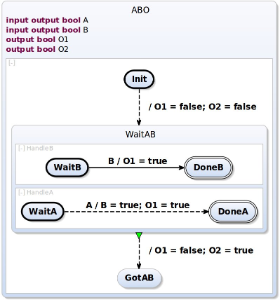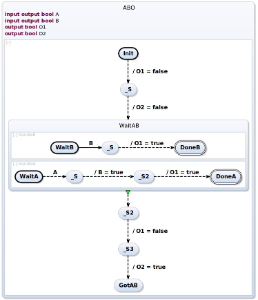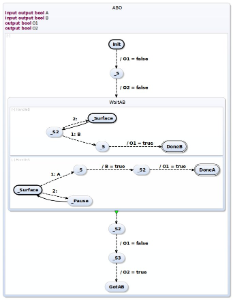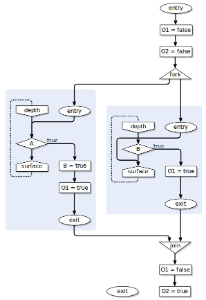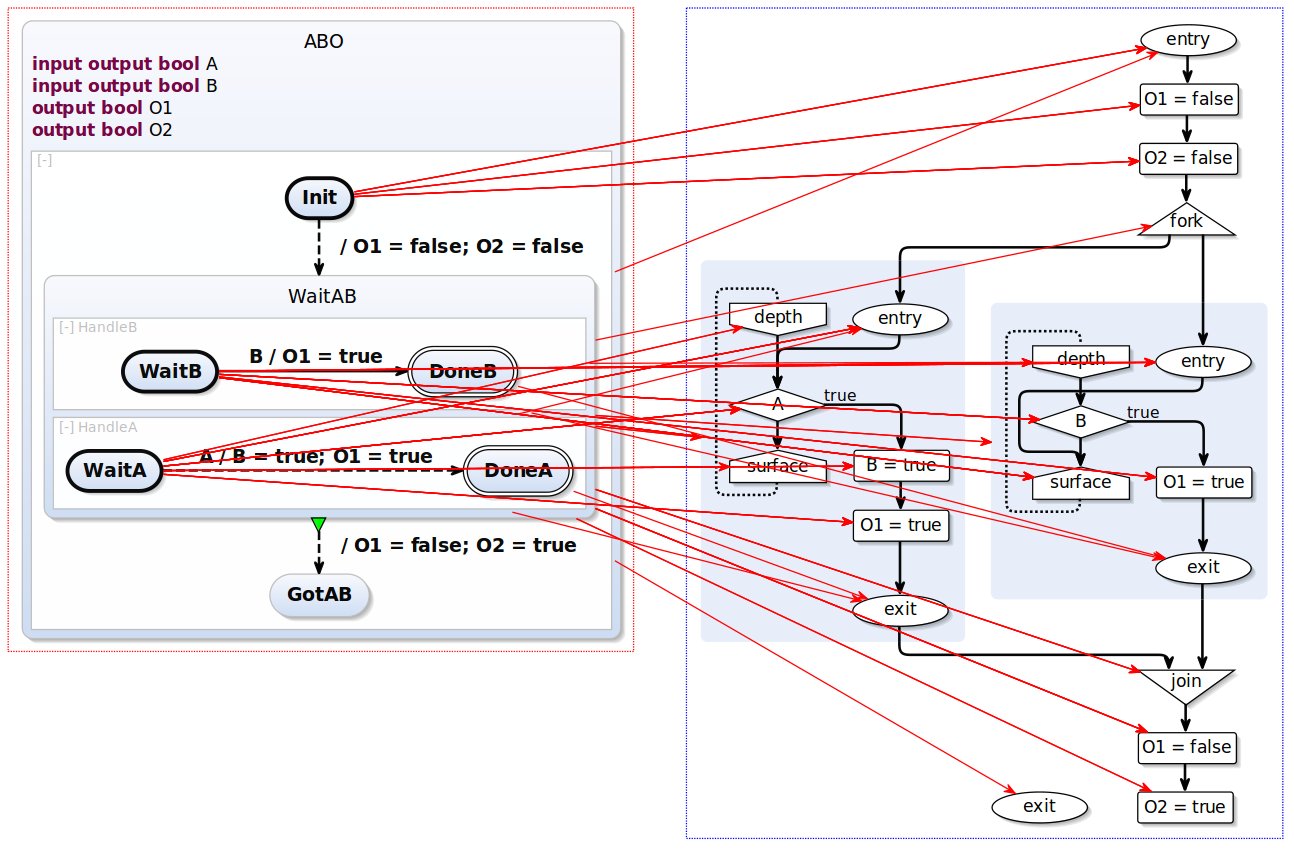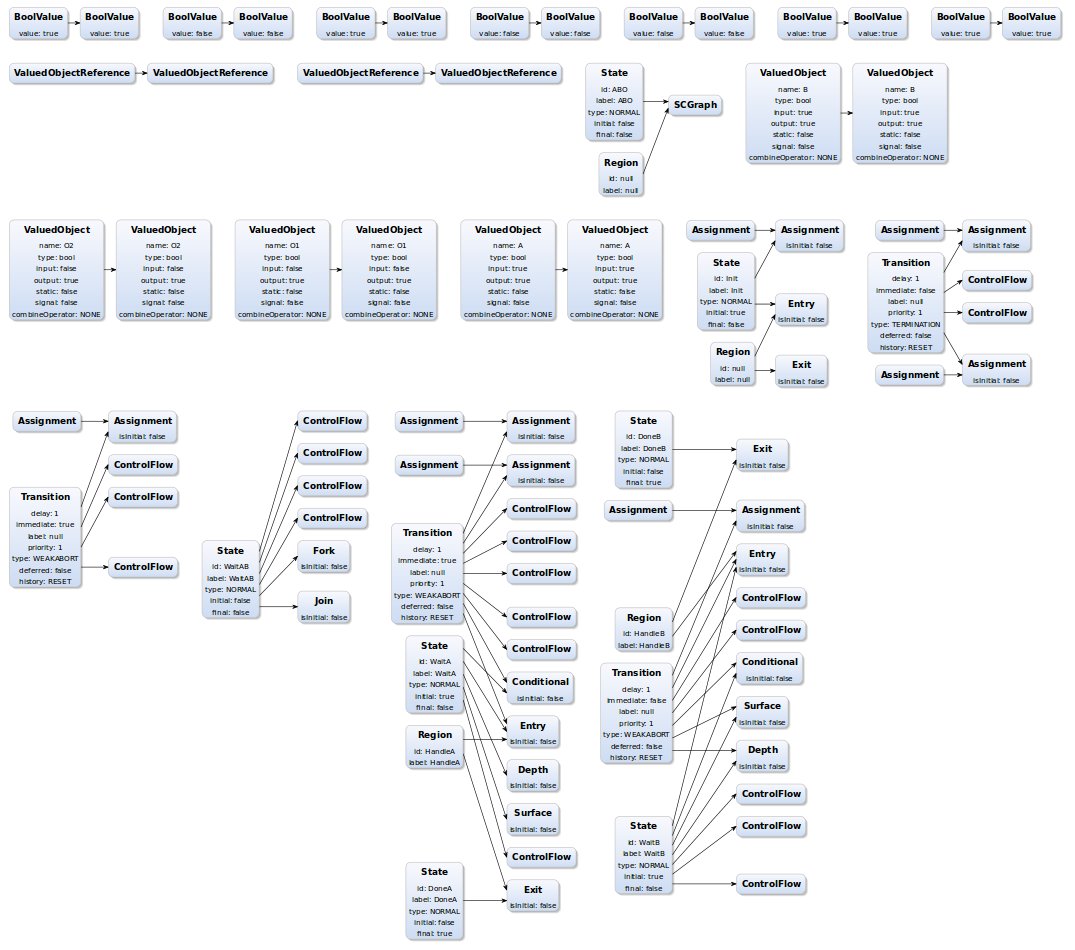Page History
KTM - KIELER Transformation Mapping
| Panel | ||||
|---|---|---|---|---|
| ||||
This article is deprecated. The described features are no longer available in current releases. KTM was redesigned is now available as KiTT . The documentation will be updated eventually. |
included in KiCool. |
Topics
| Table of Contents | ||||
|---|---|---|---|---|
|
...
Transformation Tree Model
To offer a mapping between model-elements during multiple transformations KTM introduces a model called TransformationTree to represent these relations.
...
Second part (lower half) is object-mapping. Instances of models contain EObjects as their elements, which are represented by EObjectWrapper-class in this metamodel. The EObjectWrapper of two models are connected with EObjectTransformations-class to express their origination relationship in corresponding model transformation.
An abstract example of an instance of this model:
...
The codeblock blow show a snipped of SCChartCoreTransformation with additional mapping registration.
| Code Block |
|---|
...
| |||||||||||||
| |||||||||||||
...
@Inject
extension TransformationMapping
...
// NEW - Mapping access delegation
def extractMapping() {
extractMappingData;
}
...
//-------------------------------------------------------------------------
//-- S P L I T T R A N S I T I O N --
//-------------------------------------------------------------------------
// For every transition T that has both, a trigger and an effect do the following:
// For every effect:
// Create a conditional C and add it to the parent of T's source state S_src.
// create a new true triggered immediate effect transition T_eff and move all effects of T to T_eff.
// Set the T_eff to have T's target state. Set T to have the target C.
// Add T_eff to C's outgoing transitions.
def Region transformTriggerEffect(Region rootRegion) {
clearMapping; //NEW - clear previous mapping information to assure a single consistent mapping
// Clone the complete SCCharts region
var targetRootRegion = rootRegion.mappedCopy; //NEW - mapping information (changed copy to mappedCopy)
// Traverse all transitions
for (targetTransition : targetRootRegion.getAllContainedTransitions) {
targetTransition.transformTriggerEffect(targetRootRegion);
}
val completeness = checkMappingCompleteness(rootRegion, targetRootRegion); //NEW - DEBUG
targetRootRegion;
}
def void transformTriggerEffect(Transition transition, Region targetRootRegion) {
// Only apply this to transition that have both, a trigger (or is a termination) and one or more effects
if (((transition.trigger != null || !transition.immediate || transition.typeTermination) && !transition.effects.nullOrEmpty) ||
transition.effects.size > 1) {
val targetState = transition.targetState
val parentRegion = targetState.parentRegion
val transitionOriginalTarget = transition.targetState
var Transition lastTransition = transition
val firstEffect = transition.effects.head
for (effect : transition.effects.immutableCopy) {
// Optimization: Prevent transitions without a trigger
if(transition.immediate && transition.trigger == null && firstEffect == effect) {
// skip
} else {
val effectState = parentRegion.createState(GENERATED_PREFIX + "S")
effectState.mapParents(transition.mappedParents); //NEW - mapping information
effectState.uniqueName
val effectTransition = createImmediateTransition.addEffect(effect)
effectTransition.mapParents(transition.mappedParents); //NEW - mapping information
effectTransition.setSourceState(effectState)
lastTransition.setTargetState(effectState)
lastTransition = effectTransition
}
}
lastTransition.setTargetState(transitionOriginalTarget)
}
} |
...
The following code will now perform each transformation stepwise and updates a transformation tree each step.
| Code Block |
|---|
...
| |||||||||||||
| |||||||||||||
aboSplitTE = SCCtransformation.transformTriggerEffect(abo);
ModelWrapper aboSplitTEModel =
transformationTree.initializeTransformationTree(SCCtransformation.extractMapping(), "TriggerEffect", abo, "coreSCChart", aboSplitTE, "coreSCChart-splitTriggerEffect");
aboNormalized = SCCtransformation.transformSurfaceDepth(aboSplitTE);
ModelWrapper aboNormalizedModel =
transformationTree.addTransformationToTree(SCCtransformation.extractMapping(), aboSplitTEModel, "SurfaceDepth", aboSplitTE, aboNormalized, "normalizedCoreSCChart");
aboSCG = SCGtransformation.transformSCG(aboNormalized);
ModelWrapper aboSCGModel =
transformationTree.addTransformationToTree(SCGtransformation.extractMapping(), aboNormalizedModel, "SCC2SCG", aboNormalized, aboSCG,"SCG");
tree = transformationTree.root(aboSCGModel); |
The resulting TransformationTree has following structure and representing each step and model of the transformation.
Furthermore the TransformationTree now contains mapping information for the whole transformation chain.
...
The following code has starts with an instance of the initial ABO SCChart and SCG, along with the TranformationTree above.
| Code Block | |||||||||||||
|---|---|---|---|---|---|---|---|---|---|---|---|---|---|
| |||||||||||||
| |||||||||||||
@Inject extension TransformationTreeExtensions //Find nodes of model instances in tree val aboSCCModelWrapper = transformationTree.findModel(aboSCC,"coreSCChart"); val aboSCGModelWrapper = transformationTree.findModel(aboSCG,"SCG"); //resolve val mapping = resolvemapping(aboSCCModelWrapper, aboSCC, aboSCGModelWrapper, aboSCG); |
...
The returned mapping is a multi mapping between all object in aboSCC and their resulting objects in aboSCG.
This mapping can now displayed in models or used for various information propagation between elements of the models.
Also a more detailed view is available, showing all EObjects relation.
Visualisation
If you have a TransformationTree file (.ktmt) you can open a KLighD visualisation by right-clicking on file in project-tree and selecting 'Open Transformation Tree'.
...
If Selective selective mapping edge is enabled no mapping edges are displayed. If you select (CLICK) an element in one of the two model its relation to corresponding element is displayed. You can multi-select with CTRL+CLICK or deselect by clicking on an edge.

